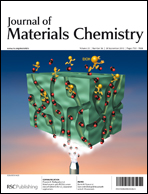Prussian blue (PB) is considered as a promising material for electrochemical biosensors. However, the PB microstructure, which is essential for biosensor performance, is difficult to control on the electrode surface due to its rapid formation reaction. In this report, the growth of a regular nano-structured PB on the platinum (Pt) electrode surface was realized by an aerosol deposition approach without a template. The morphology of PB could be controlled well via deposition time and temperature, as characterized by cyclic voltammetry (CV), atomic force microscopy (AFM), field emission scanning electron microscopy (FESEM) and high-resolution transmission electron microscopy (HRTEM). The cuboid and cubic shapes of PB nano-crystals were formed at 25 and 35 °C, respectively. When the Pt electrode with nano-cubic PB was used to detect hydrogen peroxide, it exhibited a high sensitivity (1163 mA M−1 cm−2) and an excellent anti-interference to ascorbic acid. Our observations suggest that the proposed approach may be used for regular growth of crystals having rapid formation reaction, and the prepared amperometric biosensor will have potential applications in the detection of physiological substances.

You have access to this article
 Please wait while we load your content...
Something went wrong. Try again?
Please wait while we load your content...
Something went wrong. Try again?


 Please wait while we load your content...
Please wait while we load your content...